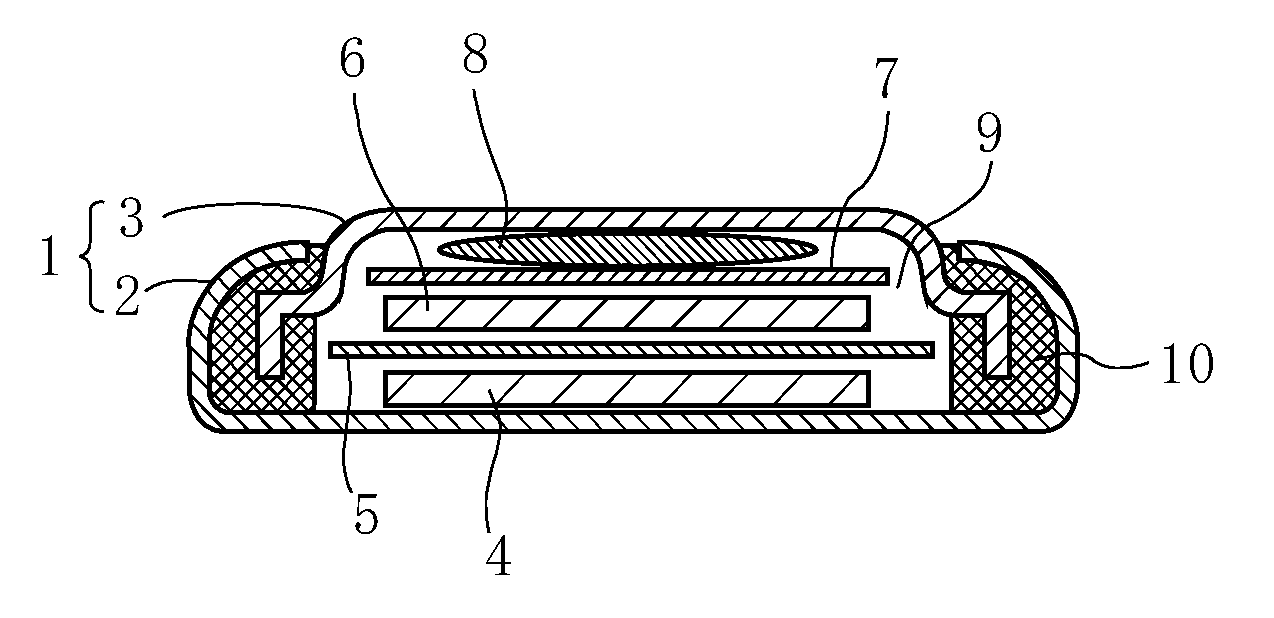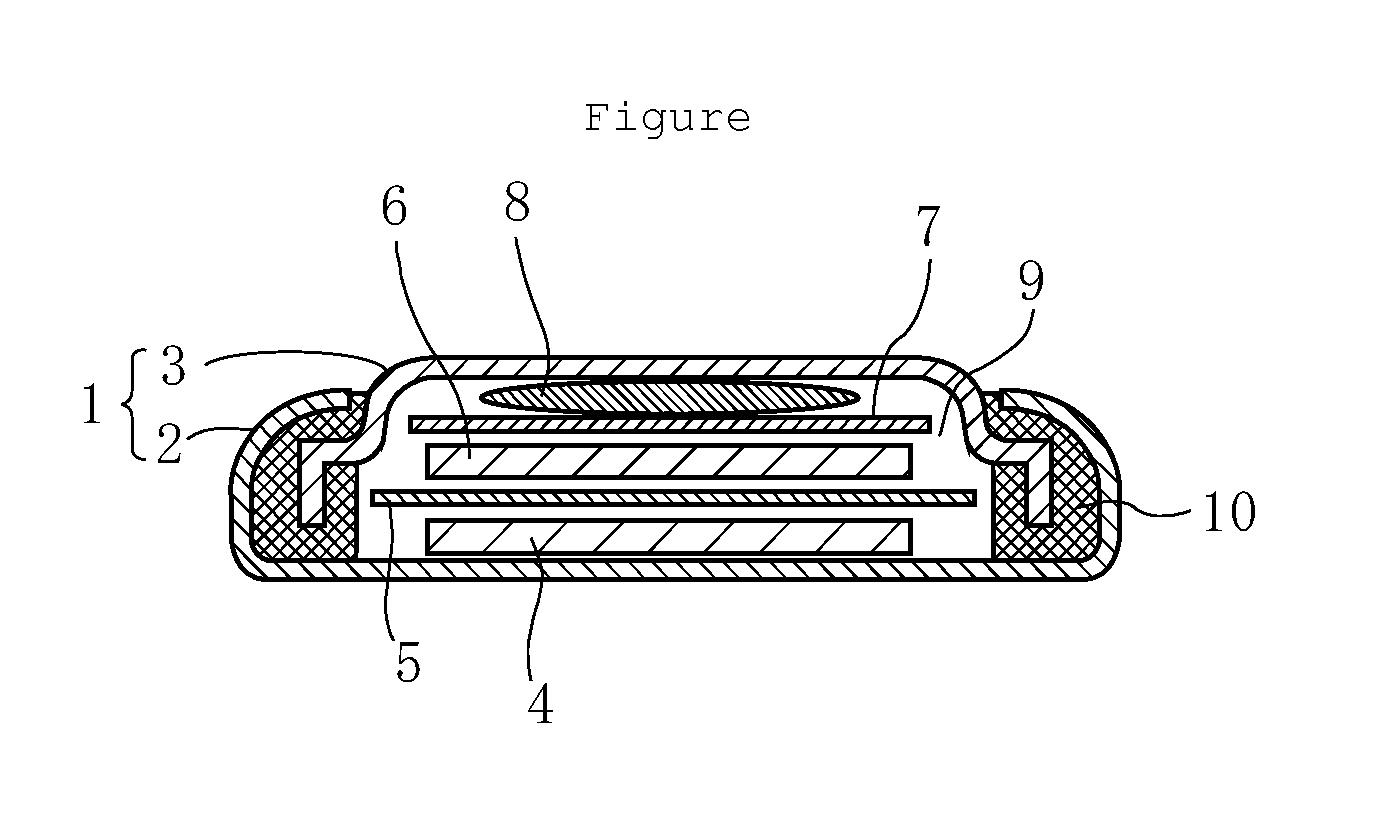Secondary Battery
a second-generation battery and battery technology, applied in the field of second-generation batteries, can solve the problems of battery stability, capacity degradation, battery lack of stability for etc., and achieve the effect of a smooth and stable charge-discharge, stable repeated charge and discharge, and short charging time and discharg
- Summary
- Abstract
- Description
- Claims
- Application Information
AI Technical Summary
Benefits of technology
Problems solved by technology
Method used
Image
Examples
example 1
Preparation of Battery
[0111]As a material for an active material, a rubeanic acid represented by the chemical formula (2a) was prepared, and as a solvent of an electrolyte, ethyl isopropyl sulfone represented by the chemical formula (1e) was prepared.
[0112]Then, 300 mg of the rubeanic acid, 600 mg of graphite powder as a conductive agent, and 100 mg of a polytetrafluoroethylene resin as a binder were respectively weighed, and these weighed materials were kneaded while being uniformly mixed as a whole.
[0113]Subsequently, the resulting mixture was pressure-formed to prepare a sheet-shaped member having a thickness of approx. 150 μm. Thereafter, the sheet-shaped member was dried at 70° C. for one hour in vacuum, and then punched out into a round shape with a diameter of 12 mm to prepare a positive electrode active material containing the rubeanic acid as the main component.
[0114]Next, the positive electrode active material was applied onto a positive electrode current collector, and fu...
example 2
Preparation of Battery
[0121]Four kinds of coin type batteries were prepared in the same manner / procedure as in Example 1 except for using, as a solvent for an electrolyte, each of chain sulfone compounds of dimethyl sulfone, ethyl methyl sulfone, methyl isopropyl sulfone and ethyl butyl sulfone instead of ethyl isopropyl sulfone.
[0122]Check of Operation of Battery
[0123]The batteries thus prepared were discharged in the same conditions as in Example 1, and their operation were checked, and consequently it was verified that the four kinds of batteries were all secondary batteries each having a discharge capacity of 0.6 mAh, which had two plateaus at a charge-discharge voltage of 2.3 V and at a charge-discharge voltage of 2.0 V.
[0124]Thereafter, a cycle of charge and discharge was repeated 20 times in a range of 4.0 to 1.5 V. Consequently, all of four kinds of the batteries could ensure 80% or more of the initial capacity. That is, the positive electrode active material was stabilized ...
example 3
Synthesis of Organic Compound
[0125]A condensate (2d) of rubeanic acid and adipic acid dichloride was synthesized according to a synthesis scheme (A).
[0126]First, 0.01 mol of a rubeanic acid (2d1) was dissolved in an aqueous solution of sodium hydroxide (mole concentration of sodium hydroxide: 0.02 mol). Then, after resulting solution was cooled to 0° C., an aqueous solution containing 0.1 mol of adipic acid dichloride (2d2) was added dropwise while stirring the solution with intensity. The resulting mixture was stirred for one hour to allow the rubeanic acid (2d1) to react with the adipic acid dichloride (2d2), washed and dried to synthesize a light brown solid, i.e. condensate (2d) of the rubeanic acid and the adipic acid dichloride.
[0127]Preparation of Battery
[0128]A coin type battery of Example 3 was prepared in the same manner / procedure as in Example 1 except for using the above-mentioned condensate (2d) for a positive electrode active material.
[0129]Check of Operation of Batter...
PUM
| Property | Measurement | Unit |
|---|---|---|
| molecular structure | aaaaa | aaaaa |
| energy density | aaaaa | aaaaa |
| voltage | aaaaa | aaaaa |
Abstract
Description
Claims
Application Information
 Login to View More
Login to View More - R&D
- Intellectual Property
- Life Sciences
- Materials
- Tech Scout
- Unparalleled Data Quality
- Higher Quality Content
- 60% Fewer Hallucinations
Browse by: Latest US Patents, China's latest patents, Technical Efficacy Thesaurus, Application Domain, Technology Topic, Popular Technical Reports.
© 2025 PatSnap. All rights reserved.Legal|Privacy policy|Modern Slavery Act Transparency Statement|Sitemap|About US| Contact US: help@patsnap.com



